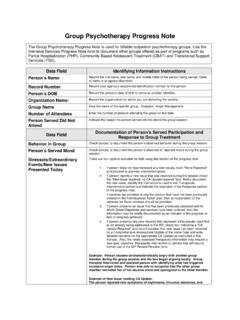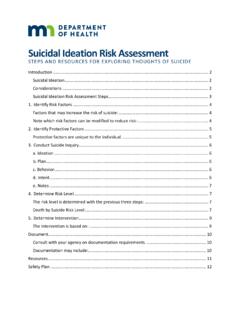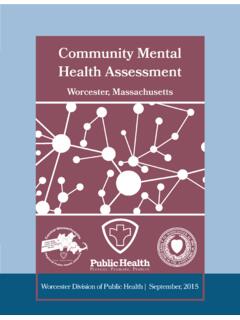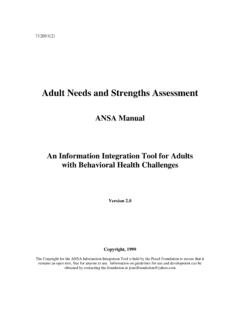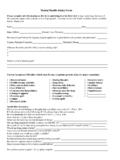Transcription of Child/Adolescent Comprehensive Assessment
1 Child/Adolescent Comprehensive Assessment The Child/Adolescent Comprehensive Assessment (C/A CA) provides a standard format to assess the mental health, substance use and functional needs of children. This Assessment provides a summary of assessed needs that serve as the basis of goals and objectives on the Individualized Action Plan. The C/A CA may be completed in concert with the child and adolescent Needs and Strengths (CANS) Assessment . Follow agency policies and procedures when choosing to complete child or Adult Comprehensive Assessment for transitional age youth (16-21) Complete the Transition to Adulthood section for children years and older. If completing the CANs Assessment , complete significant history sections only. Data Field Identifying Information Instruction Person s Name Record the first name, last name, and middle initial of the child .
2 Order of name is at agency discretion. Record Number Record your agency s established identification number for the child . Date of Admission Record the date of admission per agency policy (this should be the first service date for this service episode). Organization/Program Name Record the organization /program to which you are delivering the service. DOB Record the child s date of birth. Gender Indicate person s gender by checking the appropriate box. If checking Transgender box, also complete box of current gender designation for insurance purposes. Data Field Presenting Concerns Referral Source and Reason for Referral Document the referral source and reason the child was referred for services, from the child s/family s and the referent s point of view. What Occurred to Cause the Person to Seek Services Now (Note Precipitating Event, Symptoms, Behavioral and Functioning Needs) Record (in person s own words) precipitating factors as reported by the child /family or others that has led up to the event that caused the person to seek services.
3 Record troublesome symptoms, behaviors and/or problems affecting day-to-day functioning, relationships and work/school, as reported by the child /family. Examples: If the occurrence was having trouble in school: Feeling like I have no energy at school, getting into trouble in class, and coming in late or skipping school altogether due to not being able to get up in the morning. If the occurrence was hospitalization due to feeling suicidal, factors would include: I have had suicidal feelings for 5 days, I ve cut myself in the past, and I was drinking when I cut myself this time. Data Field Custody Custody Check all boxes that reflect the current custody arrangement for the child . If applicable, include the DCF Caseworker s name. Complete Legal status Addendum if person needs a guardian.
4 Is there a Rep Payee? Check the appropriate box. If yes, complete the Rep Payee section of the Legal Status Addendum. Is there a Conservatorship? Check the appropriate box. If yes, complete the Conservatorship section of the Legal Status Addendum. Is there a need for a Legal Guardian, Rep Payee, or Conservatorship that has not been met? Check the appropriate box and provide comments regarding the need for a Legal Guardian, Representative Payee, or Conservatorship if needed. Data Field Instructions for Integration with CANS Assessment Current Status is either captured below or in CANS Assessment . If CANS Assessment has been completed, check box. If you have completed the CANS you do not need to complete the current information for those areas noted with an * if the current status is well documented in the CANS narrative.
5 If you have not completed the CANS, complete all the following information. Comment should be included for any CANS score above a 1. Data Field Living Situation What is the person s current living situation? Check the box (or boxes) to indicate what the person s current living situation is. You are not required to check off one box under each category ( , person s home, residential care/treatment facility, other). Residential Care/Treatment Facility Check if person served is in one of these living situations. If person owns or rents an independent living situation but currently resides in residential care or a treatment facility, complete this and the previous section. At Risk of Losing Current Housing Check yes or no. If yes, provide comments that illustrate the situation.
6 Satisfied with Current Living Situation Check yes or no. If yes, provide comments that illustrate the situation. Is Person 14 years or older? Check yes or no. If yes, complete Transition to Adulthood Addendum. Data Field Family Family Functioning/Parent and child Interaction/Relationship Permanence: Include the child functioning within the context of his/her family and community. Attach Genogram/ Ecomap if completed. Record each household member s name, his/her relationship to the person served and his/her age. Examples: Mother, father, sister, family friend, foster brother/sister, step-parent. Record the household s street address if different from the address listed on the Personal Information form. Record all other significant family members and others not residing in household currently.
7 Record significant history regarding family functioning. Record current status of family functioning (if CANS Assessment not completed). Current Status Record significant history regarding Family Functioning. (if CANS Assessment not completed) History Describe current status of the Family Functioning. Data Field Developmental Information Developmental/Cognitive Delay and Functioning/Sensory/Motor/Sleep/Feeding Disorders: Include if child met developmental milestones and developmental/cognitive delay such as low IQ or developmental disability Record significant history regarding developmental functioning. Include information regarding prenatal history, developmental milestones, any disruptions in achievement of developmental tasks, or other pertinent information regarding development.
8 Examples: child did not walk until age 2 ; child was unable to successfully separate from mother to attend preschool. Record current status of developmental functioning (if CANS Assessment not completed). Current Status Record current status of developmental milestones achieved or delays in attainment History Record significant history regarding developmental milestones achieved or delays in attainment Learning Style (visual, auditory, verbal, written, or learn by doing) Describe how the person best learns new information. Current Status Describe the current status of the person's learning style. Include if person has identified or suspected learning disabilities. History Record significant history regarding the person's learning style. Learning Disability/ Communication, Comprehension and Expression: Include expressive and receptive language problems Record significant history regarding learning impairments.
9 Include information on preferred learning style. Current Status Record current status of learning impairments (if CANS Assessment not completed). History Record significant history regarding learning impairments (if CANS Assessment not completed). School: Preschool/Childcare/Behavior/Achievement /Attendance: Provide information based on age of child if older than preschool. Include current grade Record significant history regarding school behavior, academic achievement, and school attendance and absences. Include if child is on a 504 Plan or IEP. Current Status Record current status of school behavior (if CANS Assessment not completed), current level of student s academic achievement (if CANS Assessment not completed), and current status of school attendance or absence.
10 History Record significant history regarding school behavior, academic achievement, and school attendance or absence. Self-Care: Include whether child can perform age appropriate activities of daily living, assistive technology and special communication needs and ability to self-preserve Record significant history regarding self-care skills (for example toileting, grooming, eating, brushing teeth, showering, etc.). Current Status Record current status of self-care functioning (if CANS Assessment not completed). Include assistive technology and special communication needs. Include ability to self-preserve. History Record significant history regarding self-care skills (for example toileting, grooming, eating, brushing teeth, showering, etc.). Data Field Cultural and Religious Considerations Language (Primary Language and Secondary Language) Record significant history regarding the child s first and other spoken/written language skills.





